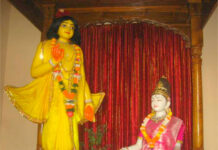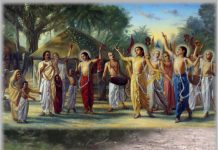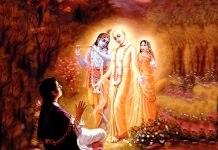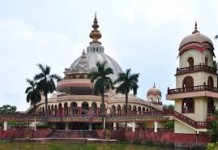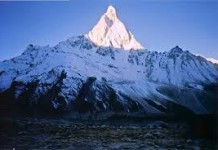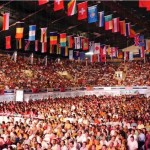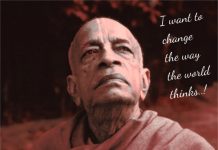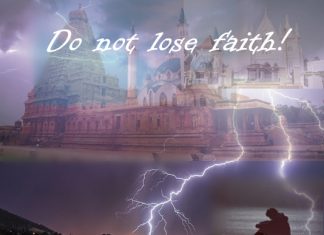Lord Shiva’s name is synonymous with being auspicious, benevolent and kind. The term ‘Shi’ or ‘Si’ depicts the ideology of all pervasiveness, that which lies in all, and all that lie within Him. The name Shiva also denotes final liberation. The depiction of Shiva as the ‘Pure One’, and one who is not affected by the Sattvik, Rajasik or Tamasik qualities of Prakriti. Lord Shiva’s is said to be all pervading in that he is the master of material energy in this world. He is beyond the barriers of space and the dimensions of time. He is perceived in his unmanifested as well as manifested form. Various texts describe different names of Lord Shiva as Rudra, Mahadeva, Mahesh, Shambhu, Mahakaal, Hara, Trilochan, Neelakantha, Trilokinath, Adinath,; all glorifying the different aspects and qualities of the Lord.
Lord Shiva is described with the term ‘Maha’ invariably, as Mahadev, meaning the chief among devas, and Maheshwar, meaning the chief among Isvaras, or controllers. Some Vedic text describe Lord Shiva as a prime constituent of the trinity, other being Lord Vishnu and Lord Brahma. Apart from controlling the task of the annhiliator and destruction of the creation at the time of Pralaya, Lord Shiva is also the destroyer of evil.
In the Shaivite tradition, Mahadev is considered to be the Supreme Being, carrying on the tasks of creation, sustenance and destruction of all creation. He remains the absolute Brahman, the only atman or soul, and hence pervades all living beings apart from being existent in all particles, material or non-material, in thought or mind, imagination or reality, living or non-living, in the past, present and the future. Shiva is said to encompass the dimensions of space, and time, and is above the bounds of time. As Shiva is depicted by an eternal pillar of light, or an ‘Anaadi Stambh’ that has no beginning and no end, no-one in this world can know Shiva. It is only by the mercy of the Lord that devotees see Him in His manifested form, as the Lord wants to show His devotee. It is hence aptly said that while all creation is said to exist, simultaneously nothing exists at all, as an atman views the Lord and all reality becomes clear when it is realized that it is a fact that in reality nothing exists. However, this explanation leaves behind number of unanswered questions when examined from the viewpoint of most important Vedic texts such as Bhagavad Gita.
Mahadev is said to simultaneously as benevolent as He is said to be fearsome. Lord Shiva has various forms; He is an ascetic and Adi-Yogi as the Lord lives on Mount Kailash, He is Aghori, Bhiru, Kapalik. Mahadev has the most unique adornments, different from the other Gods, wearing the crescent moon on His head, serpent as a garland, third eye, carries a Trishul as a weapon, wears Baghambar or tiger skin, wears matted locks, holding River Ganga in them, and rides the Nandi bull. Each of these adornments have a unique meaning and symbol, most unique to a particular way of worship and attainment of devotion towards the Lord.
The third eye is the eye beyond the limited perceptive duality that is seen by our two eyes. This eye sees beyond the illusion of Maya, not only making a living being see the realities of the other world, the spirits, real, illusory, the past, and the future but also a devotee tends to observe the Shiva-tattva in the entire manifested creation.
As Lord Shiva rides the Nandi Bull, it not only marks the innate love that Mahadev has for Nandi, but also for all cattle, and the inherent place that a bull and cattle have in the ancient Vedic culture, also known by some as Hindu culture or religion. Nandi is most loyal to the Lord, and Mahadev treats him to be as His son. Nandi is also said to be a symbol of loyalty and waiting, unexpectant of any reward. Nandi depicts the process of meditation, of combining devotion with loyalty, breaking the barriers of time in waiting which is the very basis of meditation.
The trident, or Trishul, that Lord Shiva has is a factual mighty weapon although there also are various interpretations to it. It is said to be the destroyer of evil, apart from the annihilator of the attachment to the physical world and the illusions of the atman. The Trishul is also considered by many to represent the three energy channels of the human body, the three Lokas, and the three aspects of time.
As Mahadev wears a serpent around His neck, it is symbolic of various things. The Lord conveys that He is beyond the desires of Maya, apart from the fact that the snake also depicts the power of the Kundalini Shakti. As a being starts his spiritual journey, this energy starts ascending upwards from its base, towards the attainment of spiritual knowledge.
As Mahadev applies ash or bhashma from the smashan, or crematorium, it reminds the soul that as he comes into the world, he shall go back to the other world even without his ash, and that nothing is taken away from this physical world, where in fact everything is temporarily manifested.
The story of wearing the crescent moon on His forehead comes from the curse of Daksh to Chandra, who was Daksh’s son-in law that Chandra shall wane with time and lose all of his sheen. However, as Chandra worshiped Mahadev in Prabhas Kshetra, Mahadev granted him the boon that Chandra shall wane during fifteen days in a month and then regain his luster in the next fifteen days. Keeping Chandra on His forehead, the timelessness and eternal characteristic of Mahadev are revealed, as He remains unbound by time.
Mahadev’s Damru spreads the words of the Vedas and the texts, apart from the music that is very dear to Mahadev. Said to be sitting on the tiger skin symbolizes the Abhiru nature of Mahadev, representing Him to be fearless.

The event of the marriage of Lord Shiva and Goddess Sati is mentioned in various Puranic texts. It is one of the most important events in the Shaiva and Shakti traditions of worship. However, in the present day context, these stories are referred to by the name of ‘Mythology’. It is in fact the original glorious past of ancient Indian Vedic culture and temple history was demeaned by the foreign attackers and rulers, especially the British, which would give them a leeway to prove their superiority into the minds of the general Indian public. Just as the British had falsely portrayed the Aryan Invasion Theory in order to rule India in a better and easier way, which was proved false after a substantial period of time, in the same way India’s glorious culture has been extremely demeaned and deprived by the British.
Stating the Puranic texts, the Ramayana, Mahabharata as mere mythology is not acceptable at all. As research has been done by various sources, certifying the claims that these events had indeed taken place, and are not merely children’s tales passed on from one generation to the next, the actual dating of these events are yet to be established by modern historians and archaeologists.
While modern science seem to have dated the events of Ramayana to be a few thousand years old, and the Mahabharata even closer in time, it shall take much better tools and clearer investigation to relate to all the facts that the events of the Ramayana actually took place about ten lakh (one million) years ago, and the events of Mahabharata took place around five thousand and five hundred years ago. At this time, man did not live as in the stone age, as is depicted in many modern day books. In fact, humans were much more advanced in terms of science, visiting other planets, apart from all other fields than they are today. And all this, only in this particular Kalpa.
As is stated that in each Kalpa the same sequence of events repeats itself, whether in the same special zone, or a different timely zone, the same events of Ramayana and Mahabharata and all beings in the present world have existed in the past and so shall they exist in the future also. This may or may not include the specific souls present in their respective roles each time.
There exists a lesser known story when a sage is sitting meditating and Lord Hanuman comes to him after burning Lanka and drops His ring in the sage’s Kamandalu. Lord Hanuman is surprised to see a number of similar rings already in his Kamandalu. On inquiring, the sage replied that each time Hanuman comes here after Lanka dahan in each Kalpa, he drops his ring in my Kamandalu. I have been sitting here for so many such Kalpas, you can see by counting the rings.
Even the Sati Shaktipeeth temples take us back into the glory of India’s famed Hindu past from the barriers of the present day understood ‘History’, the understated ‘Mythology’, where they bring back India from the fabled Mythology to the real existent History of the Devi Shaktipeeths.
These Peethas remain indestructible. They remain seated at their very fixed rooted spot as was initially chosen on Bhooloka in the land of Bharat varsha by Goddess Sati Herself. The Goddess established Herself for the benefit of all spiritual beings, whether in human form, animal form, as celestial, or in pure spirit. Anyone who worships the Goddess and Mahadev at these most holy seats of powers shall invariably receive the result of their worship.
The existence of these temples cannot be destroyed by the physical destruction of the temple structure. The Sati Devi Pindi remains rooted to the Earth, and can neither be destroyed, broken, uprooted nor displaced. No attack can succeed in affecting any harm to these pilgrimage spots. Lord Shiva had appointed a Kshetrapal Bhairav to protect these Peethas from the demonic forces. The purpose was to protect the real Pindi of the Devi that is Her own body part, so that it does not go into the hands of the demonic forces. This feature makes the Sati Shaktipeeths different from many other temples of worship, where the Deities were attacked by demoniac forces and may have been destroyed, as in this case the real Devi Pindi remains and has remained unharmed following innumerable attacks on these temples.
Note from the author: I have taken the content of this article from my recently published book, “The Forgotten Shivlinga of Sati Shaktipeeths”. The book is available at Zorba bookstore (https://www.zorbabooks.com/store/religion/the-forgotten-shivlings-of-sati-shaktipeeths/), Amazon (https://www.amazon.in/Forgotten-Shivlings-Sati-Shaktipeeths/dp/9387456129), and Snapdeal.
Disclaimer: Mayapur Voice does not financially benefit from the sale of the above mentioned book nor do we claim to know the full content of it. Readers are requested to do their own research in areas of their concern.


